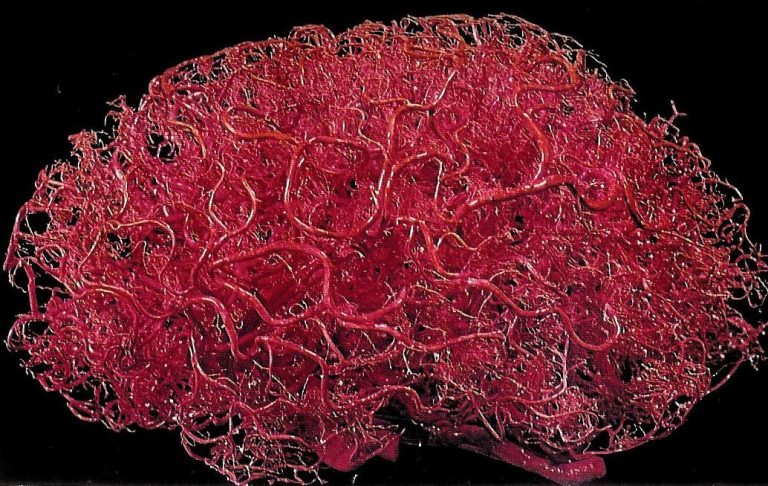Chapter 2: The Brain and Nervous System
2.7: Non-Neuronal Structures in the Central Nervous System
Ventricular System and Cerebrospinal Fluid
The cerebral ventricular system is a set of interconnected cavities known as cerebral ventricles that produce and transport cerebrospinal fluid (CSF) (Shenoy & Lui, 2022). This ventricular system is made up of 4 main ventricles—2 lateral ventricles, the third ventricle, the fourth ventricle, and the cerebral aqueduct (Figure 25). CSF is produced in the ventricles by a tissue called choroid plexus. It drains through sinuses around the brain and through lymphatic vessels. CSF fills the subarachnoid space around the brain, so the brain is suspended in CSF. CSF thus acts as a shock absorber to cushion and protect the brain. Additionally, being suspended in CSF reduces the effective weight of the brain from around 1500 grams to around 50 grams (Wright et al., 2012). Without CSF, the brain’s own weight would cut off blood supply and kill neurons especially in the lower sections of the brain. Finally, CSF circulates nutrients throughout the brain and helps clear waste products away from the brain.


Vasculature
The brain is an energetically demanding organ. It is only 2% of the body’s mass, but uses 20% of its energy when the body is resting (i.e., when muscles are not active). It relies on a constant supply of oxygen and glucose in the blood to sustain neurons—a disruption of blood flow to the brain leads to a loss of consciousness within 10 seconds. To deliver a constant flow of oxygenated blood, the brain has a complex and tightly regulated vasculature that directs blood to the most active brain regions. Four arteries feed the brain with oxygenated blood, forming a circle—the circle of Willis. Several large arteries branch off the circle of Willis to perfuse different regions of the brain. Branches of these major arteries form smaller and smaller arteries and arterioles that pass through the subarachnoid space before diving into the brain, and branch yet further to form a dense capillary network (Figure 26).
A mind-blowing 1 to 2 meters of capillaries exist in every cubic millimeter of brain tissue. These capillaries are less than 10 microns in diameter, though, so they only take up about 2% of the brain volume. This means that, in cerebral cortex, each neuron is only around 10-20 microns from its nearest capillary. This dense vascular network can therefore supply oxygen and glucose very close to active neurons.
The blood supply is finely adjusted according to the needs of each brain region. Active neurons produce molecules that dilate smooth muscle cells and pericytes on local arterioles and capillaries, increasing blood flow to these regions of increased activity. In fact this increase in blood flow usually supplies more oxygen than is needed, so that blood oxygen levels increase in active brain regions. This increase in blood oxygen gives rise to the BOLD (blood oxygen level dependent) signal that can be detected using magnetic resonance imaging and is often used as a surrogate for neuronal activity in experiments studying the function of different brain regions (see Chapter 4–Research Methods).

Text Attributions
This section contains material adapted from:
Hall, C. N. (2023). 2.1: Exploring the brain- a tour of the structures of the nervous system. In Introduction to Biological Psychology. University of Sussex Library. https://openpress.sussex.ac.uk/introductiontobiologicalpsychology/chapter/exploring-the-brain-a-tour-of-the-structures-and-cells-of-the-nervous-system/ License: CC BY-NC 4.0 DEED
Media Attributions
- CSF System © Wikipedia is licensed under a CC BY (Attribution) license
- Human ventricular system animation © Wikipedia is licensed under a CC BY (Attribution) license
- brainVesselsCorosionCast-768×486 © Hall, C. N. (2023). 2.1: Exploring the brain- a tour of the structures of the nervous system. In Introduction to Biological Psychology. University of Sussex Library. is licensed under a CC BY-NC-SA (Attribution NonCommercial ShareAlike) license
Interconnected cavities within the brain tissue that produce and secrete cerebrospinal fluid to protect the brain
Cerebrospinal fluid is an ultrafiltrate of plasma that surrounds the brain and spinal cord.

